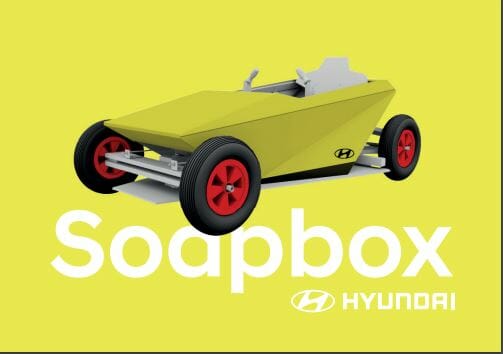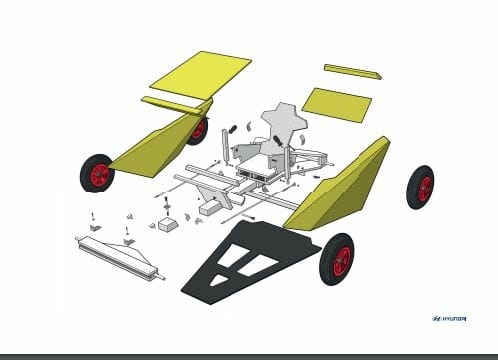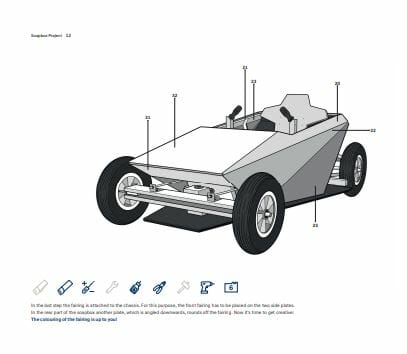As schools, colleges and offices are still closed globally, it is understandable that families are now spending more time together, than ever. To encourage everyone to spend more quality time with their loved ones, Hyundai Motor has come up with a project that would be fun for the entire family. As a mobility provider, this naturally involves something related to cars.
Hyundai Motor has designed the Hyundai Soapbox ride which parents can build together with their children. The soapbox was developed by engineers and designers from the Hyundai Motor Europe Technical Center (HMETC) using affordable and easily-available materials. The company aims to promote quality time for customers, families and friends. Also, to add make everything smooth and easy, Hyundai has made the instructions available to download so the vehicle can be built at home.

“In recent months, spending time together as a family has become more valuable to people. We wanted to create a fun project that would give families and friends an enjoyable project that brings them together,” says Andreas Christoph-Hofmann, Vice President of Marketing & Product at Hyundai Motor Europe. “Of course, the Hyundai Soapbox had to stay affordable, so our designers developed it using materials that can be easily found in a local DIY store.”
Now, in case you are wondering, Hyundai Soapbox is a motor-less, wooden vehicle designed by Hyundai experts that is nonetheless fairly easy to build. Designers and engineers at HMETC conceived the model in the company’s workshop and built a prototype to ensure the feasibility of the design. To keep it accessible, the HMETC team was careful to only use materials which were readily available at an average hardware store. They also paid attention to the total cost of materials to make sure the design stayed affordable.

According to the team, it was an interesting project for the Hyundai engineers and designers. It gave them a chance to be creative on a different type of development than usual.
“In the car industry we get so used to thinking within certain boxes, but this time, the door was open,” says Thomas Bürkle, Head of Hyundai Europe Design Center. “With this project, we were free to be creative and think outside the box.”
The Process Of Designing Soapbox
The Hyundai Soapbox was designed just like a regular car. First, a team of engineers built the chassis. Then, a team of designers sketched ideas, first on paper and then as 3D computer models. They came up with different designs, chose one, and started building. Lastly, another team worked on colour and trim.
During the building process, the body design team realised that their original design was not very feasible for people to re-create. It involved double-curved surfaces that would have been difficult to replicate using regular tools and regular building materials. So they went back to the drawing board and redesigned it.
“When designing the Hyundai Soapbox, it was important for us to ensure feasibility,” says Eduardo Ramirez, Head of Exterior Design Team at HMETC. “We didn’t want to disadvantage parents for the sake of staying true to our original design. So when the design got too complex, we needed to take a step back and rethink.”
The development team wanted the soapbox ride being simple yet demonstrating advanced thinking. So instead of using a conventional steering wheel, they adapted the joystick steering concept from Prophecy show car. However, to allow homemade build, the joysticks were made of purchased screwdrivers.
Specifications
The soapbox is made out of wood, metal rods, and connecting materials such as brackets and screws. The wheels are from a wheelbarrow. It has joysticks for steering and a simple mechanism for braking. True to Hyundai’s commitment to eco-friendly mobility solutions, the Hyundai Soapbox is made primarily from environmentally-friendly materials such as wood and metal.
Though the soapbox is built for the size of a child, due to clever engineering, it can also carry an adult’s weight. The colour of the HMETC prototype is bright yellow, which is meant to capture the optimism and joy of childhood, as well as a nod to one of the launch colours of the original Kona.

When fully assembled, the Hyundai Soapbox is 1 meter wide and 1,76m long. It was important that the soapbox could fit into a regular passenger car so that families could transport it to different locations as they look for hills to roll it down. The final soapbox design should fit into an average passenger car.
True to the concept of a soapbox, there is no powertrain – or, as Bürkle put it: “The powertrain is gravity. Your own motivation. The power of your own two legs when you push it back uphill.”
Customers can either push the soapbox up a hill or ride it down, or have two people push each other around in it – which is what the HMETC team did during testing.
Though it would be possible to install some sort of powertrain or motor into the soapbox design, Hyundai chose not to keep the prototype a true soapbox – at least in this version. The Hyundai soapbox instructions are just a basis to help people get started – parents and children should feel free to upgrade and personalise their versions however they want.
“I don’t think the point is for people to build what we design and that’s it,” says Bürkle. “Children are full of creativity, full of fantasy, and we need to leave room for that fantasy.” Whatever the result, one thing is for sure: when you build a soapbox, driving fun is guaranteed.
